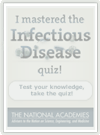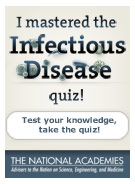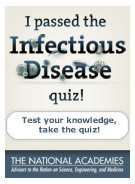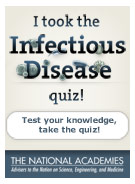
What You Need To Know About Infectious Disease
What do you know about infectious disease?
True or False: The only way public health agencies can deal with infectious disease is to have good surveillance in place, wait for an outbreak to happen in a human population, and then rush to contain it.
-
Sorry, that’s incorrect.
By identifying pathogens in the animals where they naturally live and monitoring those organisms as they move from animals into people, it may be possible to prevent deadly new infections of animal origin from entering and racing through human populations.
-
Correct!
By identifying pathogens in the animals where they naturally live and monitoring those organisms as they move from animals into people, it may be possible to prevent deadly new infections of animal origin from entering and racing through human populations.
True or False: Growing evidence suggests that infections are behind many chronic diseases once thought to be caused by genetic, environmental, or lifestyle factors.
-
Correct!Growing evidence does suggest that infections are behind many chronic diseases once thought to be caused by genetic, environmental, or lifestyle factors, including peptic ulcers and cervical, liver, and gastric cancers.
-
Sorry, that’s incorrect.
Growing evidence does suggest that infections are behind many chronic diseases once thought to be caused by genetic, environmental, or lifestyle factors, including peptic ulcers and cervical, liver, and gastric cancers.
If you have strep throat, which of the following forms of medication can be used to effectively treat the infection?
-
Sorry, that’s incorrect.
Because strep throat is caused by a bacterium called Streptococcus pyogenes, it is treatable with antibiotics but not antivirals. Currently there is no vaccine available to prevent strep throat.
-
Correct!
Because strep throat is caused by a bacterium called Streptococcus pyogenes, it is treatable with antibiotics but not antivirals. Currently there is no vaccine available to prevent strep throat.
-
Sorry, that’s incorrect.
Because strep throat is caused by a bacterium called Streptococcus pyogenes, it is treatable with antibiotics but not antivirals. Currently there is no vaccine available to prevent strep throat.
-
Sorry, that’s incorrect.
Because strep throat is caused by a bacterium called Streptococcus pyogenes, it is treatable with antibiotics but not antivirals. Currently there is no vaccine available to prevent strep throat.
The human papillomavirus (HPV) causes about what percentage of cervical cancer cases?
-
Sorry, that’s incorrect.
The human papillomavirus (HPV) causes more than 90% of cervical cancer cases.
-
Sorry, that’s incorrect.
The human papillomavirus (HPV) causes more than 90% of cervical cancer cases.
-
Correct!
The human papillomavirus (HPV) causes more than 90% of cervical cancer cases.
Each year, how many Americans become infected by what they eat?
-
Sorry, that’s incorrect.
Each year about 76 million Americans—or one in four—become infected by what they eat. Approximately 325,000 are hospitalized. More than 5,000 (14 a day) die.
-
Sorry, that’s incorrect.
Each year about 76 million Americans—or one in four—become infected by what they eat. Approximately 325,000 are hospitalized. More than 5,000 (14 a day) die.
-
Correct!
Each year about 76 million Americans—or one in four—become infected by what they eat. Approximately 325,000 are hospitalized. More than 5,000 (14 a day) die.
Which of the following is NOT a vector-borne disease?
-
Correct!
Influenza is not a vector-borne disease, meaning it is not transmitted to humans indirectly via an insect, an arthropod, or another animal. Malaria and yellow fever are transmitted by mosquitoes. Lyme disease is transmitted by deer ticks.
-
Sorry, that’s incorrect.
Influenza is not a vector-borne disease, meaning it is not transmitted to humans indirectly via an insect, an arthropod, or another animal. Malaria and yellow fever are transmitted by mosquitoes. Lyme disease is transmitted by deer ticks.
-
Sorry, that’s incorrect.
Influenza is not a vector-borne disease, meaning it is not transmitted to humans indirectly via an insect, an arthropod, or another animal. Malaria and yellow fever are transmitted by mosquitoes. Lyme disease is transmitted by deer ticks.
-
Sorry, that’s incorrect.
Influenza is not a vector-borne disease, meaning it is not transmitted to humans indirectly via an insect, an arthropod, or another animal. Malaria and yellow fever are transmitted by mosquitoes. Lyme disease is transmitted by deer ticks.
True or False: If you have a cold or the flu, taking antibiotics will help treat the infection.
-
Sorry, that’s incorrect.
Antibiotics only work on bacterial infections, not viral infections such as influenza and the common cold. In fact, inappropriate use and overuse of antibiotics contributes to the emergence of drug-resistant bacteria.
-
Correct!
Antibiotics only work on bacterial infections, not viral infections such as influenza and the common cold. In fact, inappropriate use and overuse of antibiotics contributes to the emergence of drug-resistant bacteria.
Due in large measure to the toll of infectious diseases, the gap in life expectancy between the richest and poorest countries now exceeds how many years?
-
Sorry, that’s incorrect.
The gap in life expectancy between the richest and poorest countries now exceeds 40 years.
-
Sorry, that’s incorrect.
The gap in life expectancy between the richest and poorest countries now exceeds 40 years.
-
Correct!
The gap in life expectancy between the richest and poorest countries now exceeds 40 years.
-
Sorry, that’s incorrect.
The gap in life expectancy between the richest and poorest countries now exceeds 40 years.
Which is the vector (animal that carries the pathogen) for West Nile virus?
-
Sorry, that’s incorrect.
The mosquito is the vector for West Nile virus. The mosquito suffers no ill effects from the virus but transmits it to humans and other warm-blooded creatures (such as crows) when it takes a blood meal.
-
Correct!
The mosquito is the vector for West Nile virus. The mosquito suffers no ill effects from the virus but transmits it to humans and other warm-blooded creatures (such as crows) when it takes a blood meal.
-
Sorry, that’s incorrect.
The mosquito is the vector for West Nile virus. The mosquito suffers no ill effects from the virus but transmits it to humans and other warm-blooded creatures (such as crows) when it takes a blood meal.
-
Sorry, that’s incorrect.
The mosquito is the vector for West Nile virus. The mosquito suffers no ill effects from the virus but transmits it to humans and other warm-blooded creatures (such as crows) when it takes a blood meal.
Thank you for taking our quiz.
Place this badge on your Facebook page to show your friends what you know about infectious disease.
Place this badge on your Facebook page to show your friends what you know about infectious disease.
OR, get a higher score to unlock a different badge.

Place this badge on your Facebook page to show your friends what you know about infectious disease.
OR, get a higher score to unlock a different badge.

Explore Other Topics
Disease Watchlist
Infectious Disease Defined
- Protozoa
A taxonomic group of single-celled microorganisms that live in almost every kind of habitat and include some pathogenic parasites of humans and other animals.


